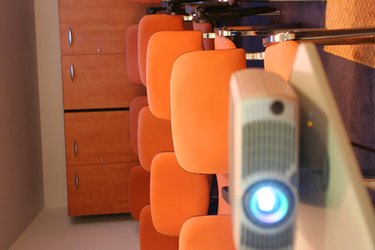
Videos and movies can actually benefit from being projected just a little bit out of focus. Business presentations, on the other hand, contain content such as text, graphs and numbers. which need to be as sharp as possible so that everyone can read them easily. Although having a projector's focus adjusted accurately is an important part of achieving a sharp image, there are a number of other factors that can also impact image quality, which range from the cleanliness of the lens to how you position the projector.
Step 1
Clean your lens. Dirt spots and fingerprint smudges add distortion to an image because they impact the light passing through them. Although you should always follow the projector manufacturer's instructions on how to clean the lens, using a microfiber cloth is usually the safest way to do clean your lens.
Video of the Day
Step 2
Adjust the projector's focus so that it is as sharp as possible. Slowly turn the focus knob until it looks like it is in focus, and then continue to turn just a little bit until it starts to go out of focus again. Turn it back the other way a bit to get perfect focus. This ensures that you find the sharpest possible setting. Projectors put their focus knob in different places, but many have a knurled ring around the projector lens that you can turn when you need to focus your lens.
Step 3
Send the right resolution to your projector by setting your computer or video device's output resolution to your projector's native resolution. For example, if you are using a widescreen projector with a Wide-Extended Graphics Adapter (WXGA) resolution of 1280 pixels wide and 800 pixels tall, set your laptop's video card to that resolution. This will prevent the projector from scaling the image and losing resolution.
Step 4
Make the projected screen size smaller. If you blow up the image too much, it will get blurry. Shrinking the image will make it smaller and, as an added bonus, brighter.
Step 5
Use the "sweet spot" of your projector's lens. Many projectors have zoom functions that enable you to change the image size without moving the projector. You can also use the zoom function to project the same size image with the projector at different distances from the screen. Typically, it is better to put the projector closer to the screen and reduce the zoom setting; however, your projector might be different.
Step 6
Position your projector to be as flat and square to the screen as possible. If you tilt the projector and use digital keystone correction to make the image square instead of trapezoidal, you will reduce the resolution. At the same time, if your projector has a lens-shift function that lets you put it off center by shifting the image over to properly center it, do not use it. The lens-shift function physically moves the lens off center relative to the projector's light source, which sends the light through the edge of the lens. Since most lenses have their sharpest optics in the center, using the lens-shift function ends up making your image less crisp.
Video of the Day